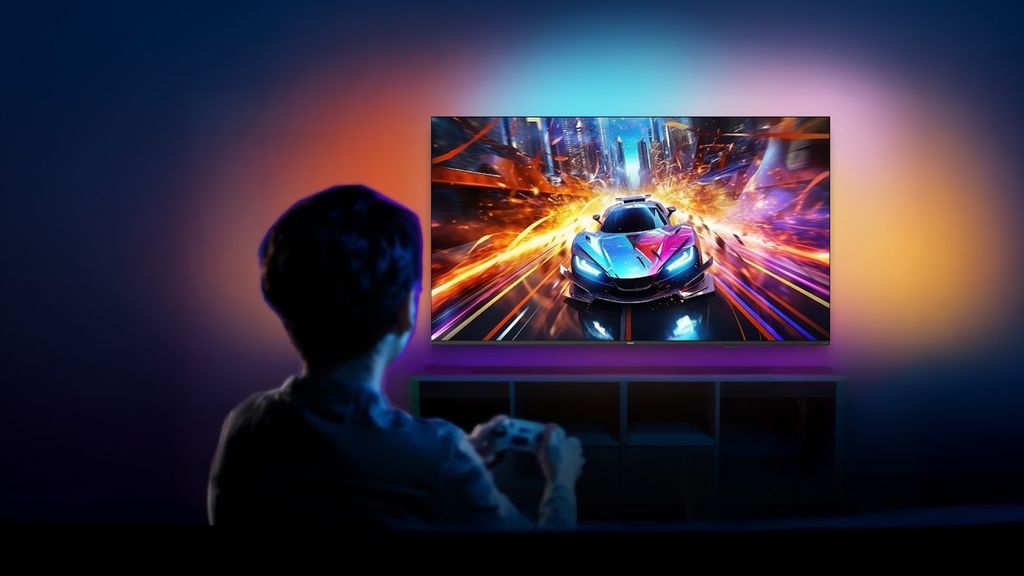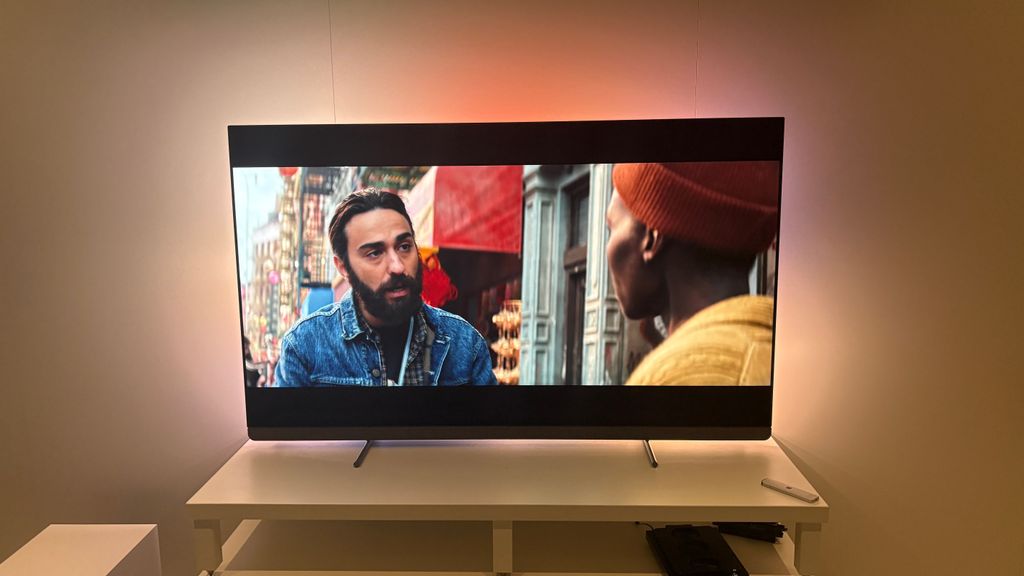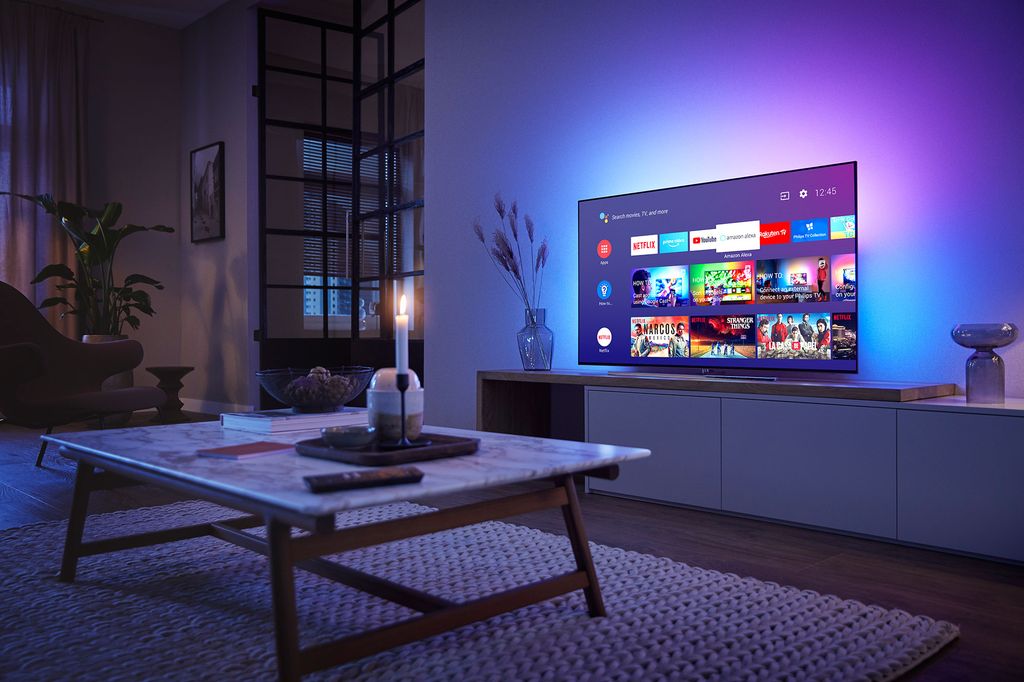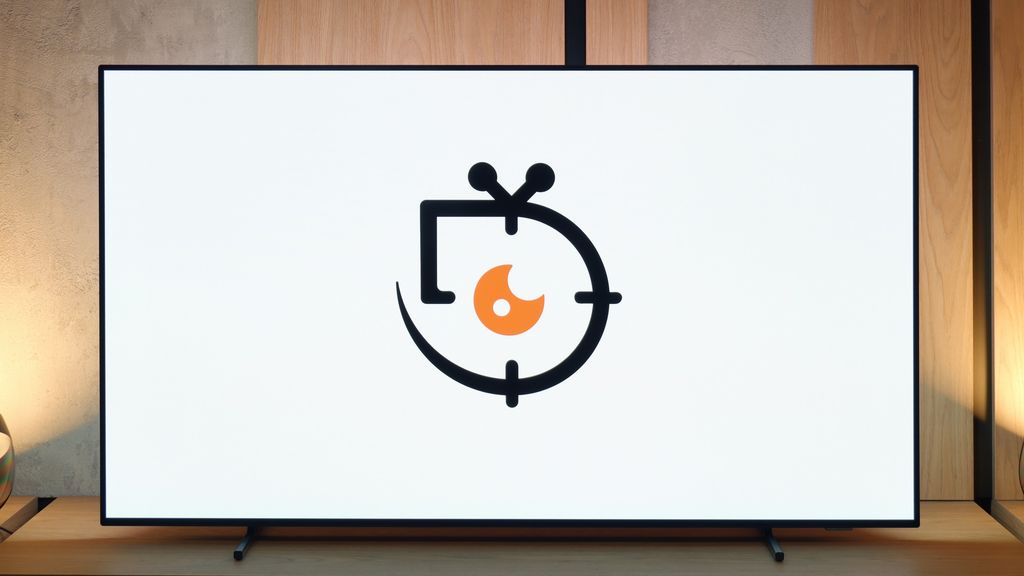- Matching (Score)
- Our verdict
- Competing TVs
- TV appearance
- Where to buy
- Contrast and black detail
- HDR effect quality
- Factory color reproduction
- Color reproduction after calibration
- Smoothness of tonal transitions
- Image scaling and smoothness of tonal transitions
- Blur and motion smoothness
- Console compatibility and gaming features
- Input lag
- Compatibility with PC
- Viewing angles
- Daytime performance
- TV features
- Apps
- Playing files from USB
- Sound
- Panel details
Philips OLED910 Review
Available screen sizes:

Complete the survey to find out the result
Panel type: WRGB OLED Refresh rate: 144Hz Brand: PHILIPS Resolution: 3840x2160 System: Google TV Model year: 2025
The Philips OLED910 is (almost) the highest representative of televisions from this brand in the offering for 2025, and at the same time, the cheapest model using the revolutionary Tandem OLED panel. It is this type of panel that we find in constructions such as the LG G5, Panasonic Z95B, or – in the largest size of 83 inches – the Samsung S95F. The panel itself is considered groundbreaking, mainly due to its unprecedented brightness in the world of organic televisions. Philips claims that the OLED910 can fully utilise its potential. How has this played out in practice? What distinguishes it from the aforementioned competition, and is it worth choosing this particular model? You will find out in our review.
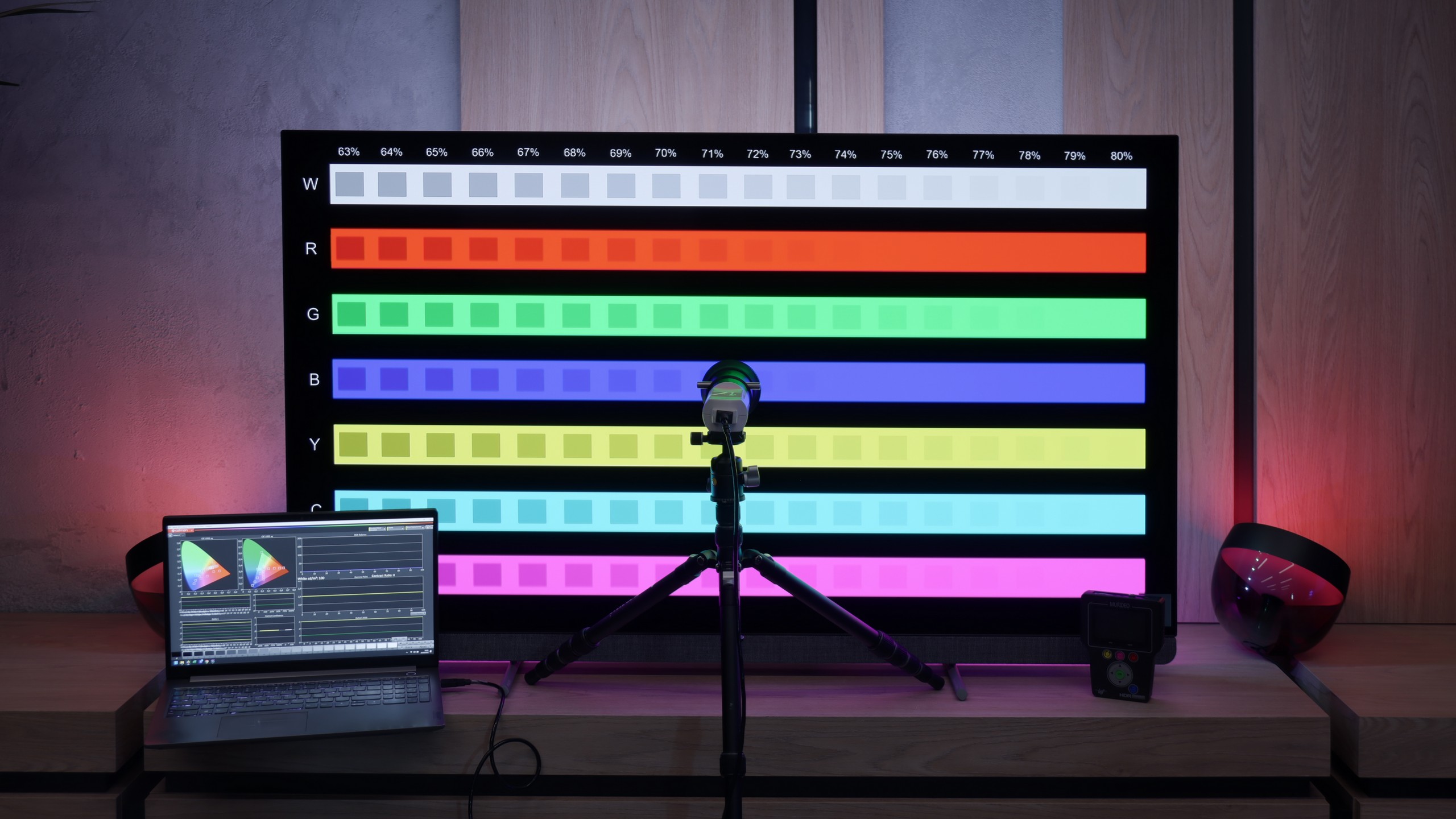
PHILIPS OLED910 - Our verdict
8.5
Overall rating
Philips OLED910 is one of the candidates for the title of TV of the Year 2025 – and we say this with full conviction. Thanks to the META panel used, specifically the Tandem OLED produced by LG Display, we get top-notch brightness that has not been seen in WOLED televisions before. Combined with perfect contrast, this provides unmatched experiences for evening viewing, which are difficult to find elsewhere. And if we add the four-sided Ambilight system to this, evening screenings can look better than on any other television. The OLED910 is not just a screen for films but also an excellent choice for gamers. The fast 144 Hz panel, along with the suite of features for gamers, does the job and gives the impression that this is equipment designed with modern gaming in mind. The sound is also worthy of special mention – in our opinion, it's the best built-in speaker system we've encountered in a television so far. The soundbar, created in collaboration with Bowers & Wilkins, demonstrates that one can do without an external setup, and if someone wishes, they can always add a subwoofer and step up to a full-fledged home cinema level. Of course, it is not the cheapest model, and compared to competitors, it requires digging deeper into your pockets. But it also has a few aces up its sleeve that make the extra cost seem justified. The question is: are you ready to spend more to have Ambilight, Bowers & Wilkins soundbar, and Tandem OLED panel? This is something everyone must evaluate for themselves. We can say one thing – by choosing the OLED910, you are purchasing one of the most interesting televisions of 2025.
Advantages
Remarkable brightness, over 2000 nits in HDR!
Perfect black levels and very high contrast
Support for all major HDR formats: Dolby Vision and HDR10+
Very low input lag, amazing for gaming
Excellent motion smoothness, 144 Hz refresh rate and support for VRR and ALLM.
Four-sided Ambilight system making a huge impression
Google TV with a massive library of apps and efficient Google Assistant.
One of the best sounding televisions thanks to the Bowers & Wilkins soundbar
Support for audio formats Dolby Atmos and DTS:X
Disadvantages
Only two HDMI 2.1 ports instead of four (this may be a limitation with more than one console)
Average font readability when working with a PC due to the lack of full chroma 4:4:4
Lack of several classic features – PiP, USB recording, infrared remote control
Price compared to the competition
Movies and series in UHD quality
8.8
Classic TV, YouTube
8.7
Sports broadcasts (TV and apps)
8.5
Gaming on console
9.5
TV as a computer monitor
6.5
Watching in bright light
7.3
Utility functions
6.4
Apps
9.6
Sound quality
9.5
Complete the survey to find out what fits your preferences
PHILIPS OLED910 - Competing TVs in this price range
PHILIPS OLED910 - TV appearance
HDMI inputs: 2 x HDMI 2.0, 2 x HDMI 2.1 (48Gbps) Outputs: Toslink (Optical audio), SPDIF (Coaxial audio), eARC (HDMI), ARC (HDMI), Mini-Jack (Headphones) Network Interfaces: Wi-Fi 2.4GHz, Wi-Fi 5GHz, Ethernet (LAN) 100Mbps
Build quality: Super Premium
Stand type: Legs
Bezel color: Graphite








Stand: Fixed
Flat design: No
Accessories: Stand, Soundbar
The Philips OLED910 is a top-of-the-range television and it's clear that the manufacturer has paid attention to detail. The first thing that catches the eye is, of course, Ambilight. But this time, we don't have the classic three-sided layout, but a full four-sided system that illuminates the entire wall behind the screen. That's why the OLED910 practically begs to be mounted on the wall. The television itself isn't the thinnest, but this makes sense as the appropriate distance from the Ambilight LEDs produces the best results here. The second strong feature is the built-in soundbar developed in collaboration with Bowers & Wilkins. It looks elegant, finished in a grey fabric that complements the overall appearance and gives the equipment a prestigious look. At the back, we also find a solid low-frequency speaker system. The whole setup is minimalist, yet very refined, and it's hard to shake the impression that the OLED910 is a showcase of Philips' prowess.
Buy at the best price
Select size:
PHILIPS OLED910 - Contrast and black detail
10/10

Result
∞:1

Result
∞:1

Result
∞:1

Result
∞:1

Result
∞:1
Visibility of details in the lights:

As expected of an OLED television, the Philips OLED910 also offers an absolute level of black and remarkable contrast. This is a natural advantage of organic technology – each pixel is controlled independently, so when it needs to be black, it simply turns off. The image gains a depth that even the best Mini-LED televisions cannot reproduce, where there is always a risk of slight "blooming" or halo effect around bright elements. With the OLED910, this is not an issue – dark scenes are entirely credible, and at the same time, the television can replicate details in highlights with great precision, preserving their natural structure. In everyday viewing, this translates to an exceptional sense of realism and a cinematic quality. In this category, the OLED910 undoubtedly deserves the highest marks.
Halo effect and black detail visibility:
PHILIPS OLED910 - HDR effect quality
8.8/10
Supported formats: HDR10, Dolby Vision, HLG Color gamut coverage: DCI P3: 99.6%, Bt.2020: 82.5%
Luminance measurements in HDR:

Result
2008 nit

Result
2109 nit

Result
2214 nit

Result
2152 nit

Result
1382 nit
The OLED910 is simply an absurdly bright television for an OLED. All thanks to the new panel from LG Display, the Tandem RGB OLED, which Philips has dubbed its "META OLED." It is this panel that allows for over 2000 nits of brightness in films, which not long ago was completely unattainable in OLEDs. The television also deserves high praise for how it handles full-screen scenes drenched in bright light. Generally, in OLEDs, brightness drops significantly during such scenes, but here it remains at an excellent level – around 1400 nits. These are almost reference values, and combined with the excellent colour reproduction at 99% DCI P3 and 82% BT.2020, it gives us an HDR effect that can confidently be called one of the best in the world.
Scene from the movie “Pan” (about 2800 nits)

Scene from the movie “Billy Lynn” (about 1100 nits)

In film scenes, the OLED910 looks simply fantastic. Thanks to its absurdly high brightness and excellent colour reproduction, even the most challenging segments, such as “The Father” or “Billy Lynn”, appear almost identical to what you would see on reference studio monitors. One might slightly notice a cooler colour tonality, but this is a detail that practically does not detract from the excellent viewing experience. The OLED910 handles these demanding scenes with such ease that it is hard not to have the impression that it does so “with a finger in its pocket”.
HDR luminance chart:
HDR luminance
Luminance of RGB colors
The OLED910 is such a bright television that in most cases, standard HDR10 is more than sufficient. The image looks great anyway, full of contrast and detail. However, in very extreme scenes where intense light (e.g. snowy shots) mixes with deep blacks, it is evident that Dolby Vision can still enhance the picture and add some details that could be lost in static HDR. Fortunately, Philips does not do things by halves, and the OLED910 supports all popular formats. It includes Dolby Vision and HDR10+, so regardless of whether you are watching Netflix, Apple TV+ or Prime Video, you can be sure that the television will show you the image in the best possible version.
Static HDR10

Dynamic: Dolby Vision

Factory color reproduction
5.5/10
Unfortunately, when it comes to colour reproduction straight out of the box, the Filmmaker mode on the OLED910 performs really poorly. The television overemphasises the blue colour, and at times it looks almost like a shop display mode. This gives the impression that the manufacturer hasn’t quite tuned the device properly. The effect is that the colours look unnatural, and the whole thing resembles a somewhat exaggerated display from a market exhibition. HDR content is presented much better, where, apart from a slight loss of detail in the blacks, there’s not much to complain about. The problem is that in everyday viewing, it’s the SDR materials that matter the most – and on the OLED910, they simply look poor and fall well short of what we would expect from a television of this class.
Color reproduction after calibration
9.4/10
Fortunately, it quickly turned out that it was not the panel causing the problems, but rather the way Philips factory-calibrated the OLED910. After calibration, the television displayed its full potential, and only then could we see what the new panels produced by LG Display were truly capable of. We primarily adjusted the white balance and brightness characteristics, successfully taming the excessive blue and giving the image a natural appearance. The final effect can be described as excellent. Errors on the Color Checker palette rarely exceeded a value of 3, which in practice means an image close to perfection and colours presented in accordance with the creators' intent. In SDR content, the effect was outstanding, and in HDR, the improvement was even more noticeable – gradients became cleaner, and colours fuller and more accurate. After calibration, the OLED910 transformed from a disappointing television into equipment that can confidently be referred to as a reference in terms of colour quality.


PHILIPS OLED910 - Smoothness of tonal transitions
7/10
When it comes to colour combinations, the OLED910 performs quite well. In bright scenes, especially where strong bright colours dominate, it is difficult to spot any serious problems and the image looks very clean. It is less impressive in darker sections, closer to the grey palette – there you can notice characteristic banding, which may start to irritate more demanding viewers after a longer period of watching. Overall, however, it is a decent level and in most films or series, the effect should not be particularly bothersome.








Image scaling and smoothness of tonal transitions
7/10
Smooth transition function

Image without overscan on the SD signal

The previously visible colour banding can largely be mitigated thanks to a feature called "distortion reduction." Like in the OLED820, it is best set to a medium level, as it then produces fairly decent results – smoothing out unwanted tonal transitions while not taking away too much detail from the image. Although at times the effect may be slightly too aggressive, this function can be considered useful for everyday viewing.
As for image scaling, the OLED910 performs really well. The test material featuring a model had a soft look characteristic of Philips – at times almost too soft – but this can be easily corrected with the sharpness slider, allowing you to adjust the image to your own preferences. It's also worth noting that the television has no issues with overscan, which still occurs in some competitor models. It's a small detail, but it's pleasing because it means that all content, even the oldest, is displayed as it should be.
PHILIPS OLED910 - Blur and motion smoothness
8.5/10
Maximum refresh rate of the panel: 144Hz
Film motion smoothing option: Yes
Blur reduction option: Yes
BFI function 60Hz: No
BFI function 120Hz: No

OLED910 is a television with a refresh rate of 144 Hz. It’s a bit of a shame that Philips didn’t opt for 165 Hz, as we know that the panel used is capable of that. On the other hand, such a bonus would mainly benefit PC gamers, as in everyday use, the most important refresh rate is 120 Hz, which is fully sufficient. Combined with the advantages of the OLED panel – lightning-fast pixel response time and the absence of motion blur, the image is impeccably sharp and quick, even in dynamic action scenes. The traditional motion smoother from Philips, called “Motion Style,” also deserves praise. We can easily adjust it to our preferences: the “Fluidity” slider is responsible for films and allows you to choose between a more “filmy,” cinematic character and a smooth, theatrical image. Meanwhile, the “Motion Blur Reduction” slider is intended for sports, where it’s worth setting it to the maximum value to ensure that the image is clear and distinct during very fast shots.
Blur (native resolution, maximum refresh rate):



Blur (4K@144Hz):



The OLED910 handles motion blur excellently, just like every OLED. The pixel response time is practically instantaneous, so the image remains sharp even during very fast camera movements. There is no stretching effect or "trails" behind objects, which can be a drawback of LCD televisions. One might wonder about an even sharper image thanks to the BFI feature, but this model does not include it. However, this is no loss, as in practice BFI often brings more problems than benefits, causing flickering, double contours, and a significant drop in brightness. The OLED910, without any additional tricks, still offers motion that is sharp as a razor!
PHILIPS OLED910 - Console compatibility and gaming features
9.8/10
ALLM: Yes
VRR: Yes
VRR range: 48 - 144Hz
Dolby Vision Game Mode: Yes
Correct implementation of HGIG: Yes
1080p@120Hz: Yes
1440p@120Hz: Yes
4K@120Hz: Yes
Game bar: Yes


The OLED910 is fantastic for gaming. It supports 144 Hz, so if someone has a powerful PC, they can comfortably utilise that potential. On consoles, the most important thing is still 120 Hz, and everything works perfectly here. There's VRR, an automatic gaming mode, and even Dolby Vision in games and HGiG mode, so we really get a full package of gaming features. Philips has also added a Game Bar, which is a quick menu that displays basic information and allows you to enable a few useful things. It may not look as modern as the competition, but it works and fulfils its purpose. The only downside is the number of HDMI 2.1 ports. There are only two, which can be quite disappointing for a TV in this class. If someone connects two consoles and something additional through eARC - like a soundbar (which doesn't make much sense in this model but I'll discuss that in the paragraph about sound) - they'll have to do some adjustments. Other than that, the OLED910 has everything we expect from a gaming television.



PHILIPS OLED910 - Input lag
10/10
In terms of input lag, the OLED910 has nothing to be ashamed of. In 120 Hz mode, the delay is around 5 ms, which is a reference result and guarantees instantaneous response. With 60 Hz materials, the values rise to around 13 ms, but this is still a very good result, entirely sufficient even for demanding gamers. Importantly, even in Dolby Vision, the input lag remains low, so you can enjoy both excellent picture quality and full responsiveness.
| SDR | HDR | Dolby Vision |
|---|---|---|
| 1080p60: 13 ms | 2160p60: 13 ms | 2160p60 DV: 13 ms |
| 1080p120: 5 ms | 2160p120: 5 ms | 2160p120 DV: 5 ms |
| 2160p60: 13 ms | ||
| 2160p120: 5 ms |

PHILIPS OLED910 - Compatibility with PC
6.5/10
Chroma 444 (maximum resolution and refresh rate): No
Font clarity: Average
Readability of dark text and shapes: Very Good
Input lag in PC mode (4K, maximum refresh rate): 5ms
Matrix subpixel arrangement: BWRG
Max refresh rate: 144Hz
G-Sync: Yes
The OLED910 connected to a computer performs excellently in games. It has a 144 Hz refresh rate, very low input lag, and G-Sync support, so everything runs smoothly and without delays. For gaming, it's really hard to find any faults. It’s worse if someone wanted to work with text on it. Standard black-and-white fonts look fine, but the problem starts when colour elements appear in the document. The lack of full chroma 4:4:4 support causes such text to appear slightly blurred. For everyday office work, it’s a mediocre solution.
PHILIPS OLED910 - Viewing angles
7.6/10
Brightness drop at an angle of 45 degrees: 28%
The OLED910 performs very well in this regard. The new Tandem OLED RGB panel means that we no longer have the advantage that older MLA panels could pull off in a showdown with QD-OLEDs. Here, instead of a "remarkable" level, we simply have "very good." Brightness does drop a bit when viewed at an angle, but colour saturation is maintained, and even with a larger deviation, the picture looks appealing. It will be difficult to find a situation where the viewing angles in this model actually bother anyone.
PHILIPS OLED910 - Daytime performance
7.3/10


Panel finish: Glare
Reflection suppression: Decent
Black levels during daytime: Very Good
Panel brightness
Average luminance SDR
Philips OLED910: 614 cd/m2
PHILIPS OLED910 - TV features
6.4/10
System: Google TV
System performance: Good
- HDMI inputs: 2 x HDMI 2.0, 2 x HDMI 2.1 48Gbps
- Outputs: Toslink (Optical audio), SPDIF (Coaxial audio), eARC (HDMI), ARC (HDMI), Mini-Jack (Headphones)
- Network Interfaces: Wi-Fi 2.4GHz, Wi-Fi 5GHz, Ethernet (LAN) 100Mbps
- TV reception: DVB-T, DVB-T2, DVB-S, DVB-S2, DVB-C
Classic features:
Recording to USB (terrestrial TV): No
Recording programming: No
Picture in Picture (PiP): No
RF remote control (no need to aim at the screen): Infrared
Backlit remote control: Yes
Teletext: Yes
Audio only mode: Yes
Bluetooth headphones support: Yes
Simultaneous Bluetooth headphones & TV audio: No
Smart features:
AirPlay: Yes
Screen mirroring (Windows Miracast): No
Voice search: Yes
Voice search in native language: Yes
Ability to connect a keyboard and mouse: Yes






Google TV and Smart Features
The OLED910 operates on the Google TV system, which is definitely its strong point. We have access to a huge library of applications, from popular streaming platforms to niche programmes. In addition, there is voice search and Google Assistant, which works really well and understands even less obvious commands like "check the weather" or "give me a horror movie suggestion for tonight". There is also support for AirPlay, which facilitates cooperation with Apple devices. Unfortunately, classic screen mirroring simply did not work in our tests, so we cannot count this aspect as a positive.
Classic Features
As for more traditional solutions, the OLED910 does not offer anything special. It has a rarely seen mini-jack headphone socket, which may be useful for seniors or those using older speakers. The remote has backlit buttons, which is convenient, but at the same time operates via infrared, so you have to aim at the screen, which seems anachronistic in 2025. Although you can use headphones and speakers on the TV simultaneously, unfortunately, only wired – wireless connection is not possible, which is a slight inconvenience as who would want to use wired headphones today? There is also a lack of PiP function and the ability to record materials to USB.
4-Sided Ambilight System
And of course, Ambilight. The OLED910 comes with a full four-sided system. It makes the television seem larger, and the content viewed gains additional depth and a more impressive character. The effect is really strong, especially when the television is mounted on the wall and the light fills the entire surroundings. It is one of those additions that is hard to give up once you have tried it.
Sound connection options
HDMI audio:
Other audio outputs:
Toslink: Yes
Coaxial: Yes
Stereo (Mini-Jack): Yes
Wireless audio:
Bluetooth: Yes
DTS Play-Fi: Yes
Supported audio formats (external HDMI eARC audio):
Dolby Digital Plus 7.1: Yes
Dolby True HD 7.1: No
Dolby Atmos in Dolby Digital Plus (JOC): Yes
Dolby Atmos in Dolby True HD: No
DTS:X in DTS-HD MA: Yes
DTS-HD Master Audio: Yes
Senior accessibility
Numeric keyboard on TV: Yes
Font size adjustment: Yes
Audio description: Yes
PHILIPS OLED910 - Apps
9.6/10























PHILIPS OLED910 - Playing files from USB
9.5/10

| Maximum photo resolution: | Supported photo formats: |
|---|---|
The OLED910 handles playback of files from a pendrive or a disk connected via USB with ease. It supports virtually all popular video, photo, and music formats, so you are unlikely to encounter something it cannot open. The player itself looks quite simple, almost clunky, but it operates efficiently. And if someone misses more advanced options, they can always download VLC or another program from the Google Play store.
PHILIPS OLED910 - Sound
9.5/10
88dB
Maximum volume
Supported codecs
(TV speakers)
Dolby Digital Plus 7.1
Dolby True HD 7.1
Dolby Atmos in Dolby Digital Plus (JOC)
Dolby Atmos in Dolby True HD
DTS:X in DTS-HD MA
DTS-HD Master Audio
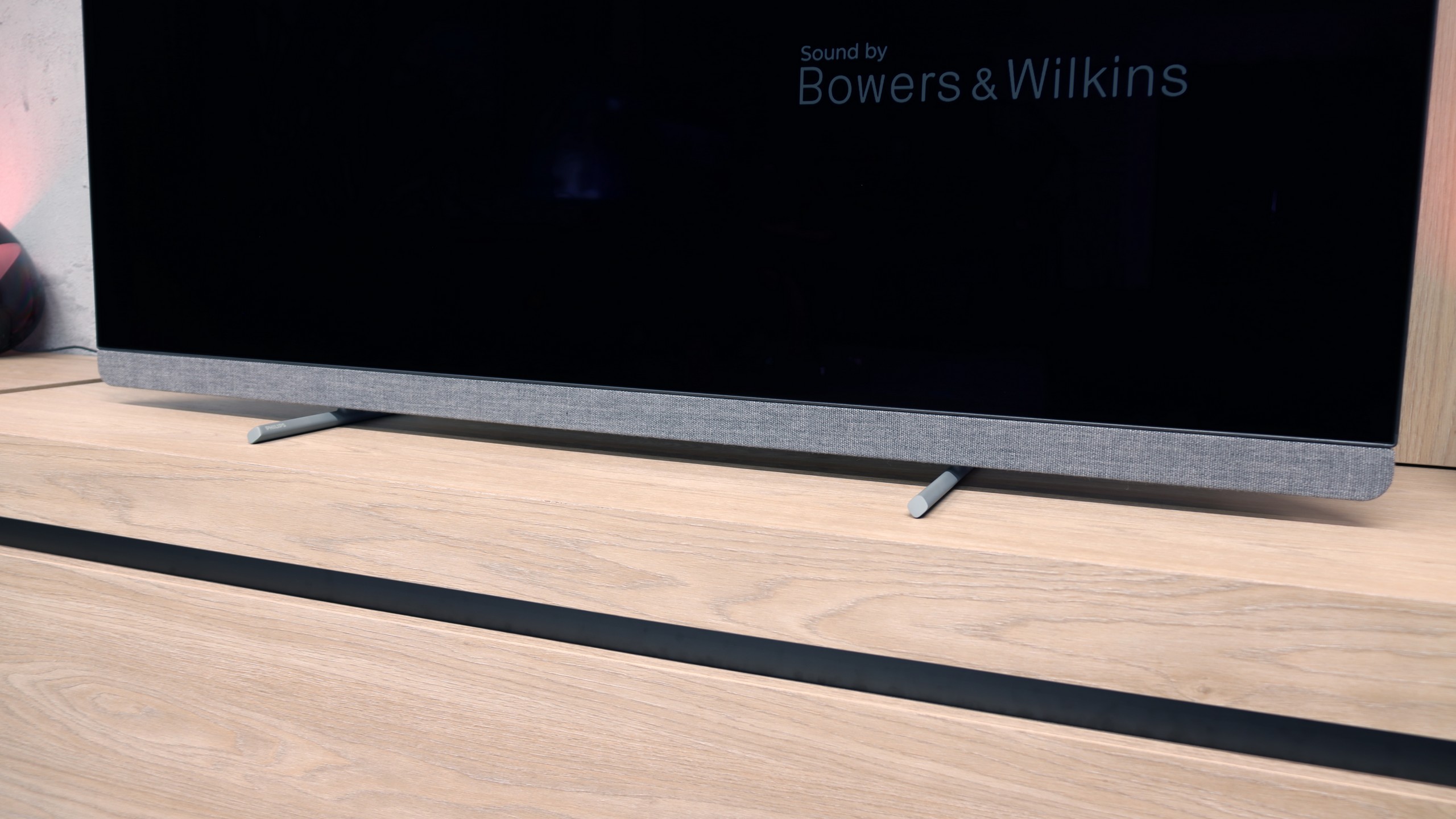
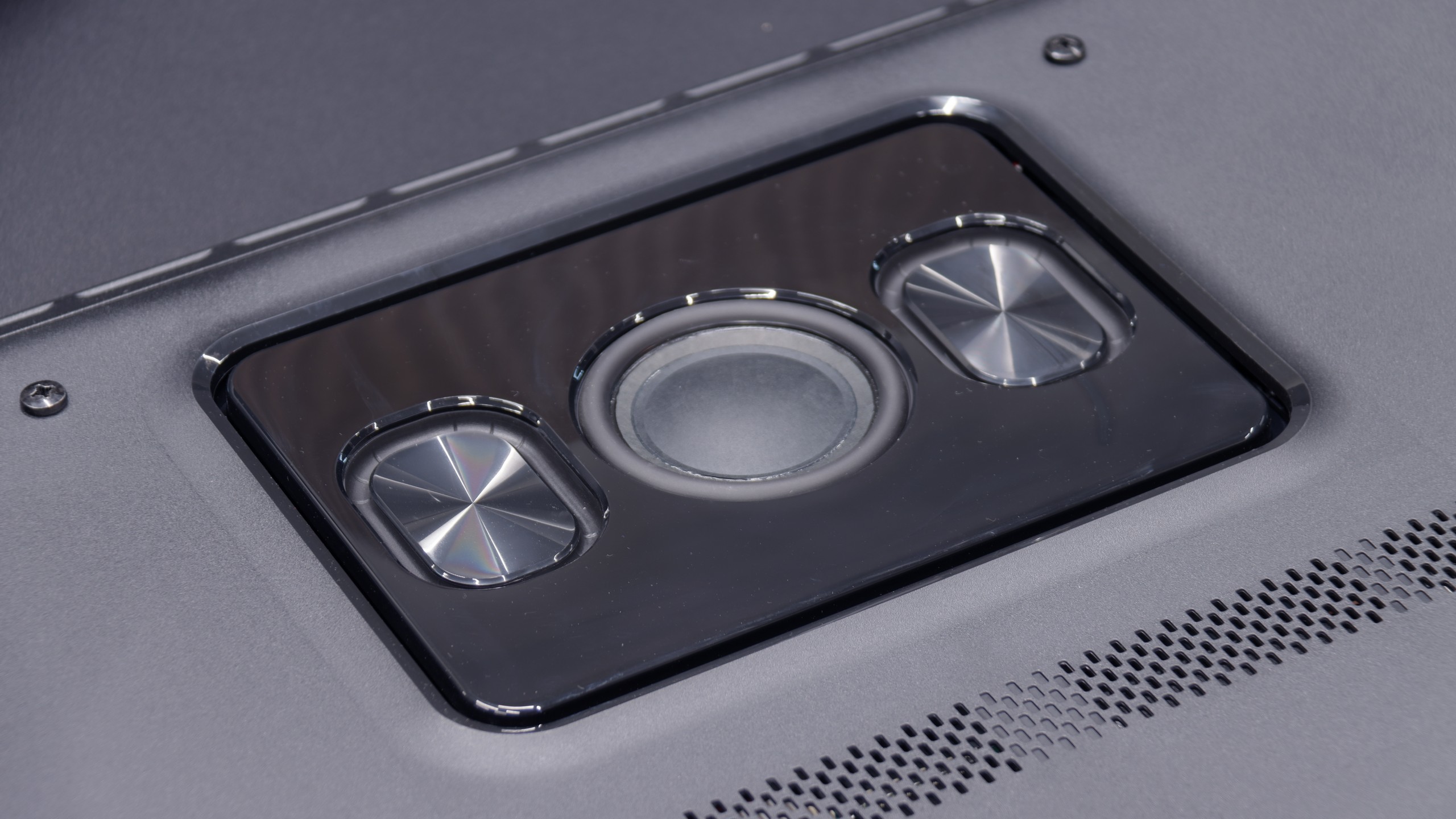
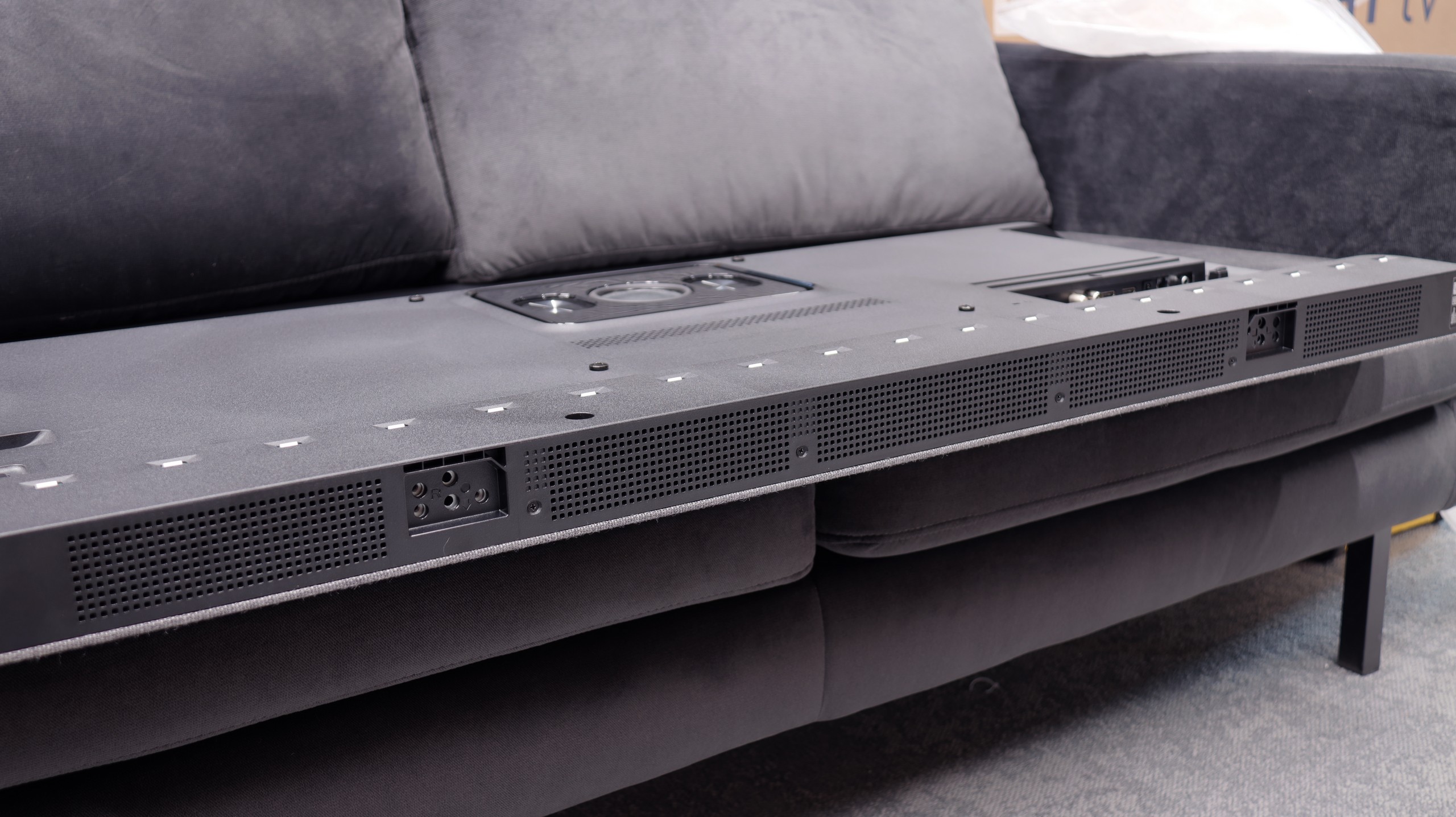



This is one of the best-performing televisions we have had the opportunity to test in the editorial office. The built-in soundbar does all the work here, and it can comfortably be said that it can replace basic external audio systems. The sound is deep, clear, and truly enjoyable, and the collaboration with Bowers & Wilkins proves to be not just a marketing gimmick, but a real enhancement of sound quality. If someone would like to take a step further, Philips offers the possibility of connecting an external subwoofer thanks to a dedicated pre-out connection. With such a setup, it reaches a level that is hard to find in televisions – and one can confidently talk about truly cinematic experiences.
Acoustic Measurements
88dBC (Max)
75dBC
PHILIPS OLED910 - Panel details
Software version during testing: TPM231WW_R.201.100.146.207
Image processor: MT5896 3GB RAM
Subpixel Structure:
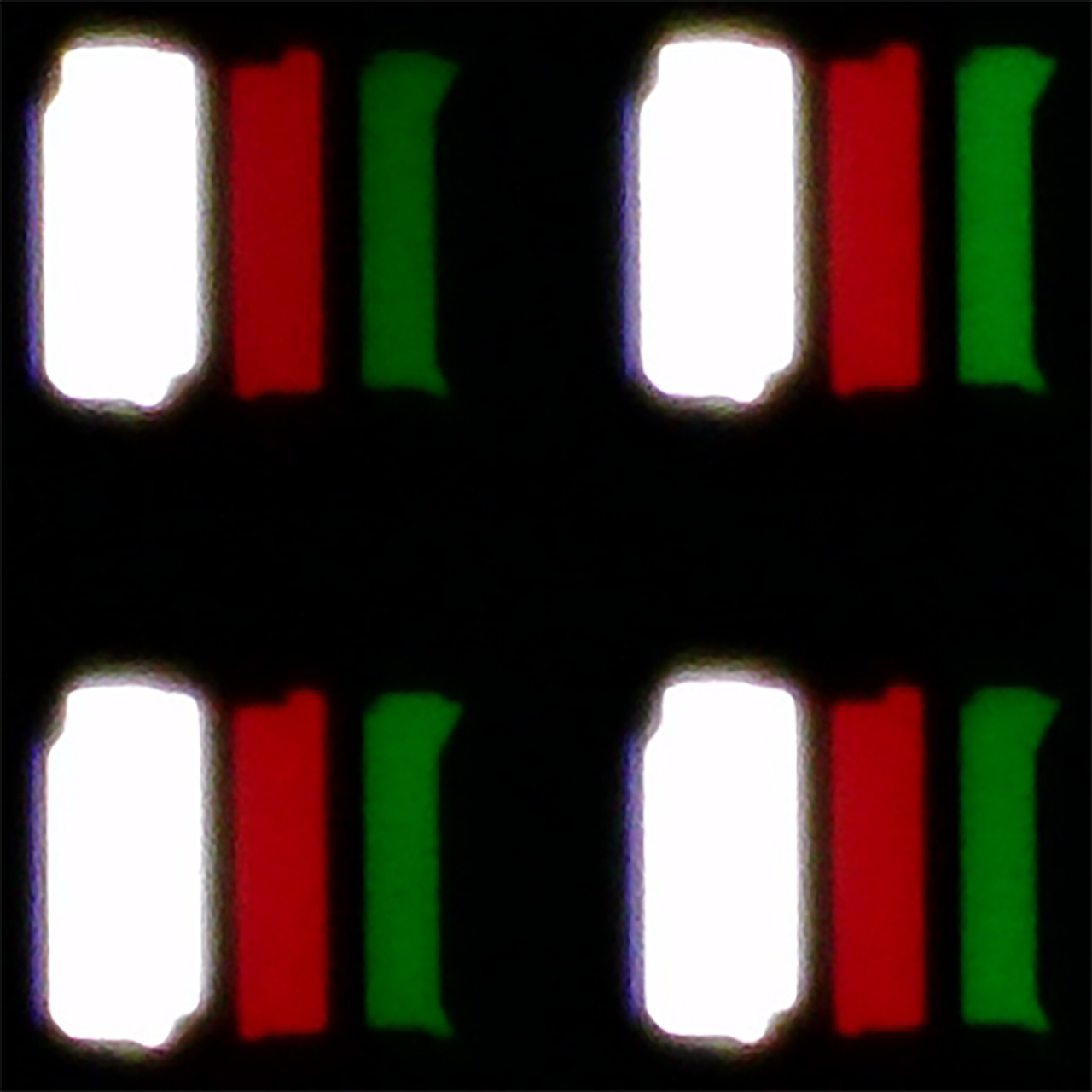
Panel uniformity and thermal imaging:

Founder and originator of the "ChooseTV" portal

Journalist, reviewer, and columnist for the "ChooseTV" portal
See articles related to Philips OLED910:
10/2/2025
4/3/2025
7/17/2025
9/8/2025
Shopping Reviews
The best Philips TVs of 2024 – these models are worth buying... 5/22/2025




